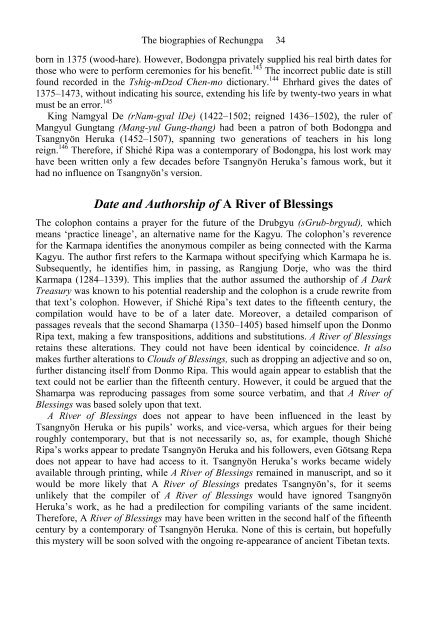The Biographies of Rechungpa: The Evolution of a Tibetan ...
The Biographies of Rechungpa: The Evolution of a Tibetan ...
The Biographies of Rechungpa: The Evolution of a Tibetan ...
You also want an ePaper? Increase the reach of your titles
YUMPU automatically turns print PDFs into web optimized ePapers that Google loves.
<strong>The</strong> biographies <strong>of</strong> <strong>Rechungpa</strong> 34<br />
born in 1375 (wood-hare). However, Bodongpa privately supplied his real birth dates for<br />
those who were to perform ceremonies for his benefit. 143 <strong>The</strong> incorrect public date is still<br />
found recorded in the Tshig-mDzod Chen-mo dictionary. 144 Ehrhard gives the dates <strong>of</strong><br />
1375–1473, without indicating his source, extending his life by twenty-two years in what<br />
must be an error. 145<br />
King Namgyal De (rNam-gyal lDe) (1422–1502; reigned 1436–1502), the ruler <strong>of</strong><br />
Mangyul Gungtang (Mang-yul Gung-thang) had been a patron <strong>of</strong> both Bodongpa and<br />
Tsangnyön Heruka (1452–1507), spanning two generations <strong>of</strong> teachers in his long<br />
reign. 146 <strong>The</strong>refore, if Shiché Ripa was a contemporary <strong>of</strong> Bodongpa, his lost work may<br />
have been written only a few decades before Tsangnyön Heruka’s famous work, but it<br />
had no influence on Tsangnyön’s version.<br />
Date and Authorship <strong>of</strong> A River <strong>of</strong> Blessings<br />
<strong>The</strong> colophon contains a prayer for the future <strong>of</strong> the Drubgyu (sGrub-brgyud), which<br />
means ‘practice lineage’, an alternative name for the Kagyu. <strong>The</strong> colophon’s reverence<br />
for the Karmapa identifies the anonymous compiler as being connected with the Karma<br />
Kagyu. <strong>The</strong> author first refers to the Karmapa without specifying which Karmapa he is.<br />
Subsequently, he identifies him, in passing, as Rangjung Dorje, who was the third<br />
Karmapa (1284–1339). This implies that the author assumed the authorship <strong>of</strong> A Dark<br />
Treasury was known to his potential readership and the colophon is a crude rewrite from<br />
that text’s colophon. However, if Shiché Ripa’s text dates to the fifteenth century, the<br />
compilation would have to be <strong>of</strong> a later date. Moreover, a detailed comparison <strong>of</strong><br />
passages reveals that the second Shamarpa (1350–1405) based himself upon the Donmo<br />
Ripa text, making a few transpositions, additions and substitutions. A River <strong>of</strong> Blessings<br />
retains these alterations. <strong>The</strong>y could not have been identical by coincidence. It also<br />
makes further alterations to Clouds <strong>of</strong> Blessings, such as dropping an adjective and so on,<br />
further distancing itself from Donmo Ripa. This would again appear to establish that the<br />
text could not be earlier than the fifteenth century. However, it could be argued that the<br />
Shamarpa was reproducing passages from some source verbatim, and that A River <strong>of</strong><br />
Blessings was based solely upon that text.<br />
A River <strong>of</strong> Blessings does not appear to have been influenced in the least by<br />
Tsangnyön Heruka or his pupils’ works, and vice-versa, which argues for their being<br />
roughly contemporary, but that is not necessarily so, as, for example, though Shiché<br />
Ripa’s works appear to predate Tsangnyön Heruka and his followers, even Götsang Repa<br />
does not appear to have had access to it. Tsangnyön Heruka’s works became widely<br />
available through printing, while A River <strong>of</strong> Blessings remained in manuscript, and so it<br />
would be more likely that A River <strong>of</strong> Blessings predates Tsangnyön’s, for it seems<br />
unlikely that the compiler <strong>of</strong> A River <strong>of</strong> Blessings would have ignored Tsangnyön<br />
Heruka’s work, as he had a predilection for compiling variants <strong>of</strong> the same incident.<br />
<strong>The</strong>refore, A River <strong>of</strong> Blessings may have been written in the second half <strong>of</strong> the fifteenth<br />
century by a contemporary <strong>of</strong> Tsangnyön Heruka. None <strong>of</strong> this is certain, but hopefully<br />
this mystery will be soon solved with the ongoing re-appearance <strong>of</strong> ancient <strong>Tibetan</strong> texts.











